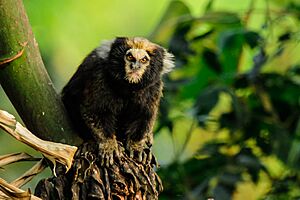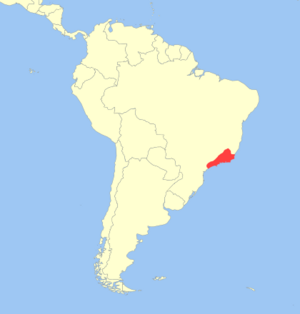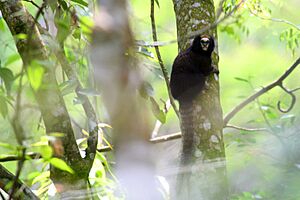Buffy-tufted marmoset facts for kids
Quick facts for kids Buffy-tufted marmoset |
|
|---|---|
 |
|
| Conservation status | |
| Scientific classification | |
| Genus: |
Callithrix
|
| Species: |
aurita
|
 |
|
| Synonyms | |
|
|
The buffy-tufted marmoset (Callithrix aurita) is a small monkey from the Americas. It's also known as the buffy tufted-ear marmoset or white-eared marmoset. These monkeys live in the forests along the Atlantic coast in southeast Brazil. They live further south than any other marmoset species.
The buffy-tufted marmoset looks a bit like the common marmoset. However, it is slightly bigger. It has grey-black skin. You can tell it apart by its whitish face and brown crown. It also has shorter ear tufts.

Where They Live
The buffy-tufted marmoset lives only in the Atlantic Forest of southern Brazil. They can be found in wet forests and forests that lose some leaves. These areas are in the Serras do Mar and Mantiqueira mountain ranges. This includes the states of Minas Gerais, São Paulo, and Rio de Janeiro. Their home range extends north of the Rio Doce in Minas Gerais.
These marmosets usually move and find food in the lower parts of the forest. They prefer dense plants, typically 6 to 9 meters (about 20 to 30 feet) above the ground. Along with the buffy-headed marmoset, they live in areas with the most extreme weather. They live in different types of forests. This includes evergreen, semi-deciduous, and mixed mountain forests. They also live where bamboo grows. They can be found at heights from 80 to 1200 meters (about 260 to 3,900 feet).
What They Look Like
The buffy-tufted marmoset is mostly black. Some may have reddish spots or speckles. These spots give them a golden color, which is why they are called "aurita" (meaning "eared" or "golden-eared"). Their forehead is white. The sides of their face are black, sometimes with red speckles.
They have short ear tufts, about 20 to 50 mm (0.8 to 2 inches) long. These tufts are usually white but can be brownish. Their feet are brown, and their hands are a faded brown color. Their tail is black with white rings.
This species is likely the largest in the Callithrix group. They weigh between 400-450 grams (about 0.9-1 pound). Their body is 19-25 cm (7.5-10 inches) long. Their tail is even longer, at 27-35 cm (10.6-13.8 inches).
How They Live
Buffy-tufted marmosets are active during the day. They live almost their entire lives in trees. They usually live in groups of 4 to 8 individuals. Sometimes, groups can have up to 11 members. In each group, there is only one male and one female that have babies. This female is the leader of the group.
Baby marmosets are always born as twins. They are born after about 144 days of pregnancy. The parents carry the babies for the first few weeks. Older brothers and sisters help take care of the young. When the young marmosets grow up, they leave their group. They find other groups to form new pairs.
Their active time is shorter when the weather is hot and dry. During the rainy season, they are active from about 6:30 AM to 7:00 PM. In the dry season, they are active from 7:30 AM to 4:30 PM. They rest in places with thick plants.
They eat tree sap and other plant liquids. They also eat plant parts like fruits and tree gum. When it's dry, they change their diet to include animals. They eat things like butterfly larvae, grasshoppers, cockroaches, spiders, and harvestmen. They also eat small snakes, lizards, frogs, and bird eggs. Studies show they can even eat bamboo fungi.
They can live in the same areas as other monkey species. These include monkeys from the Cebus and Callicebus groups. However, they are not known to live in the same areas as other types of Callithrix marmosets.
Protecting Them
The buffy-tufted marmoset is on the list of endangered species. This is true for the states where it lives in Brazil. It's also on Brazil's national and global endangered lists.
The main reasons they are in danger include:
- They live in a small area.
- Their forest homes are being destroyed.
- Their numbers are decreasing.
- They face competition from other species.
- They are mixing with non-native marmosets. These include the common marmoset (Callithrix jacchus) and the black-tufted marmoset (C. penicillata). This mixing can lead to hybridization, which threatens the pure species.


